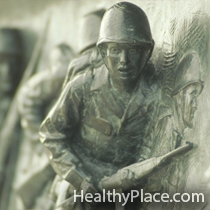Combat PTSD Symptoms – Avoidance
As I mentioned last time, the symptoms of combat posttraumatic stress disorder (PTSD) fall into four categories that include: re-experiencing, avoidance, negative changes in beliefs and feelings and hyperarousal. Today I want to talk about the combat PTSD symptoms that fall into the avoidance category.
What is Avoidance in Combat PTSD?
The term “avoidance” characterizes the symptoms of combat PTSD that surround avoiding thoughts and feelings about, and reminders of, the initial trauma. While wanting to avoid unpleasant thoughts and feelings is natural, when these habits become extreme they can interrupt daily life and prevent healing in PTSD.
What Are the Types of Avoidance?
There are two types of avoidance: emotional avoidance and behavioral avoidance. Emotional avoidance happens when a person consciously avoids feeling or thoughts about a stressful or traumatic event. Whenever a thought or feeling crosses the mind of the survivor he or she pushes it away and tries to think of other, more pleasant things. While this type of avoidance is understandable, it can stand in the way of recovery.
 Behavioral avoidance is when a person avoids all reminders of a trauma. For example, a combat veteran may stop watching any news related to the military or combat areas. A reminder of an event is often called a trigger and triggers can be almost anything depending on the person. A sight, smell, sound or even taste can cause unwanted thoughts and feelings about the trauma and behavioral avoidance works to reduce any presence of these triggers.
Behavioral avoidance is when a person avoids all reminders of a trauma. For example, a combat veteran may stop watching any news related to the military or combat areas. A reminder of an event is often called a trigger and triggers can be almost anything depending on the person. A sight, smell, sound or even taste can cause unwanted thoughts and feelings about the trauma and behavioral avoidance works to reduce any presence of these triggers.
Impact of Avoidance on Daily Life
While avoiding reminders of trauma and unpleasant thoughts and feelings about a trauma might seem quite reasonable, when this behavior becomes extreme it tends to negatively impact daily life as well as a veteran’s ability to recover from combat PTSD.
An impact on daily life can be seen in this example: a veteran may not want to walk down the street where a military recruitment office is as it’s a trigger of his or her time in combat. Even if the veteran’s favorite restaurant is on the same street, he or she will not venture down it. Of course, the veteran can no longer eat at his or her favorite restaurant. The more triggers a person works to avoid, the more of an impact it has on daily life and functioning.
Avoiding thoughts and emotions surrounding the trauma often affects a person’s ability to recover from PTSD as they cannot process and move beyond those thoughts and feelings if they do not allow them to occur.
Avoidance tends to be driven by fear: fear that once you start crying you may never stop or fear that your rage will overtake you and you’ll do something dangerous. Giving in to this fear all the time will tend to breed more fear and anxiety and make the symptoms of PTSD worse.
Dealing with the Negative Thoughts and Feelings Surrounding a Traumatic Event
It’s worth remembering that not all avoidance is bad. If, for example, you’re in the middle of a dinner party and feelings about a trauma surround you, it’s natural and even helpful to push them away – for the time being. What isn’t helpful is avoiding all thoughts, feelings and reminders all the time.
Seeking help to deal with overwhelming thoughts and emotions is often critical in PTSD recovery. A therapist can help you process those feelings and thoughts such that they no longer overwhelm you in everyday life. Healing can happen, and when it does, those thoughts and feelings won’t bring about the overwhelming pain they once did. Moreover, little by little, you will be able to handle the things that once reminded you of your trauma and begin to associate them with new experiences. You may never be able to read stories of war without thinking of your time in combat, but you may find that those stories no longer trigger the overpowering emotions and thoughts they once did.
You can also connect with Dr. Harry Croft on his website, Google+, Facebook, Linkedin and Twitter.
APA Reference
Croft, H.
(2014, August 28). Combat PTSD Symptoms – Avoidance, HealthyPlace. Retrieved
on 2026, January 11 from https://www.healthyplace.com/blogs/understandingcombatptsd/2014/08/combat-ptsd-symptoms-avoidance
